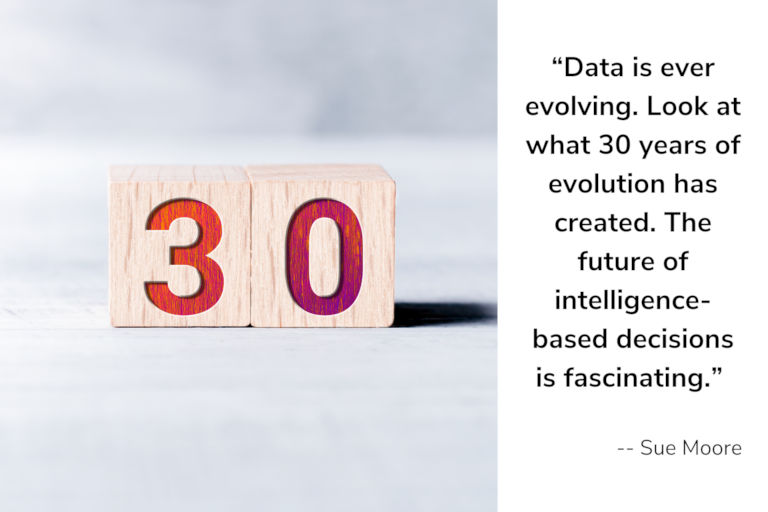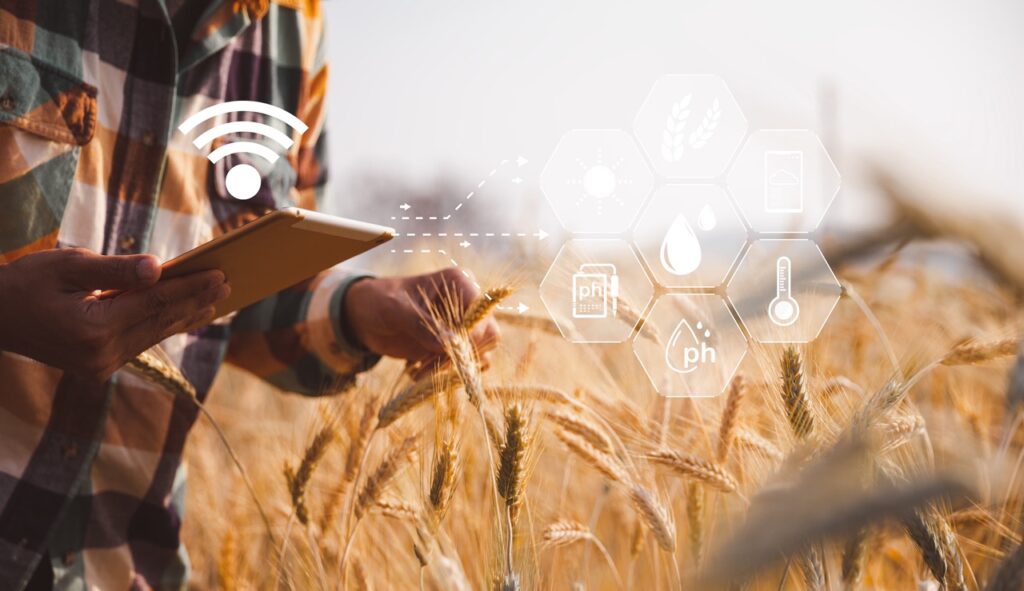
Milestone birthday alert. FreeWave turns 30 in 2023 and I’d like to take you on a journey of data over the last three decades – taking a look at where data has been and its sci-fi-like role in our future.
Since FreeWave is all about transforming data into real knowledge for real people, I drew from a broader perspective about the bits and bytes of the data of life. The ideas here are inspired by FreeWave’s innovation team. From a serial inventor to our founder, each has shaped the field of technology in their own right.
Sure, the first time someone uttered the words “big data” (October 1997, in case you’re curious) is interesting, but how has the term itself changed the way we live and work? As Steve Jobs said: “You can’t connect the dots looking forward; you can only connect them looking backwards.” Thus, this is more taking stock of data’s backstory over a cold IPA than a mundane timeline.
Thirty candles on the cake commands a little self-reflection. The wild days of our youth are behind us. We’re all grown up now, and while data may be following its own trajectory, the parallels are pretty fascinating.
I start where all great stories begin. My “why.”
I grew up in the Midwest where a lot of the technology that we use today was born and innovation spans generations. I remember “playing office” with with my father’s paperwork at home (I guess remote offices were a thing, back in the day). He worked at Motorola (a company I would later join) for decades. He was a regional sales rep during the the early 80s when he was on special assignment, working on this thing called “cellular.” His company car’s trunk was filled with black boxes – and there was even a phone mounted in the center column between the front seats. It was cool to use. I thought I was cool for being able to use it. So, I was hooked, not only on technology, but the data seemingly flying there and there to make that all possible.
From there, I guess I just followed in Dad’s footprints, although I chose a marketing path, and 40 some years later, here I am, still watching technology expand. Still fascinated by how those ones and zeroes are writing the world’s story.
It’s 1993: Do You Know Where Your Floppy Disks Are?
The year is 1993. Bill Clinton is president, Beanie Babies have hit the market, Intel has introduced the Pentium microprocessor, and 3½ inch floppy disks in bright colors are scattered across desks (unlike its austere sibling, the silver compact disk). In a small office somewhere in Boulder, Colorado, the FreeWave cofounders are meeting with a couple of ladies who make dreamcatchers. FreeWave was born among the likely stacks of floppies used to store code for FreeWave products to come.
And, we can’t forget that the then new Colorado Rockies threw out its first pitch in the National League West (to date, we have never won our division – but, boy, we’ve got great mountain views!).
“When we first started, wireless was used in many applications, but not to anywhere near the extent it is today. The early applications for our products were the precursor to IIoT (Industrial Internet of Things) and showed how important data was,” says Steve Wulchin, CEO and cofounder of FreeWave.
After earning his MBA at the University of Texas, Steve was hired by Hewlett Packard. His first desktop computer at HP had a 5MB hard drive (yes, megabytes!). Cell phones and the internet didn’t exist, and Apple was a company that was pretty much left for dead by the rest of the tech world. That, he says, is the cool thing about technology. “Look at where we are now,” he says. “We may not have flying cars, but we do have a lot of unbelievable things that few could have imagined back then.”
Like technology, life has its own twists and turns. “I never planned to move to Houston post-college, never planned to get an MBA, and absolutely never planned to start a company,” says Steve. Yet, he did. FreeWave has come a long way and is now innovating around end-to-end solutions so companies better understand operational, performance, and revenue opportunities through their data.
Also from the 90s, computer scientist Michael Lesk writes: “There may be a few thousand petabytes of information all told.” (IDC predicts the global datasphere will reach 175 Zettabytes by 2025.) Using data as insight also saw the light of day. In 1993, digital mobile phones went from analog to digital, giving way to applications, data transfer, and mobile hotspots. In 1995, M2M began using cellular as a backhaul solution. And in 1999, SMS pricing and data plans fell to affordable rates.
Things, the Rise of Data in the Aughts and the Value of Insight
Once people realized Y2K (for zoomers, this was the potential crash of computers on December 31, 1999) was a non-issue, the world was off and running.
We snapped photos with our phones, put our taxes on flash drives, carried a thousand songs in our pocket, and connected on Facebook. During the 2000s, “things” like washing machines were predicted to connect to the internet and order detergent. So far, most of us are still putting Tide on the grocery list. However, IoT has indeed given rise to a tsunami of data.
According to the IoT Analytics “State of IoT—Spring 2023” report, the number of global IoT connections grew by 18% in 2022 to 14.3 billion active IoT endpoints. In 2023, the global number of connected IoT devices is predicted to grow another 16%, to 16.7 billion active endpoints.
In the plainspoken world of marketing where I play, a “billion active endpoints” is a lot of data flowing through a lot of connected things.
The term “big data” was first used at an IEEE conference on visualization in 1997. Michael Cox and David Ellsworth authored “Application-Controlled Demand Paging for Out-of-Core Visualization,” stating: “Visualization provides an interesting challenge for computer systems: data sets are generally quite large, taxing the capacities of main memory, local disk, and even remote disk. We call this the problem of big data. When data sets do not fit in main memory (in core), or when they do not fit even on local disk, the most common solution is to acquire more resources.”
The data has always been there; it just took a while to figure out how to best leverage it. To explore data’s evolution, I tapped Richard Reisbick, FreeWave’s vice president of engineering and inventor of more than 20 tech products.
“Upwards of 2.5 quintillion bytes of data are generated each day,” he says. “The value of that data is estimated to be $274 billion. Today, that data is processed to find correlations that were not thought of in 1997.”
Advancements, he explains, in hardware and software have allowed big data to create machine learning applications that can determine if events are happening through the use of a simple camera feed.
“Facial recognition can now be performed on a $10 processor using more data than a hard drive could hold in 1997. Data science is now a field that uses this data to help understand macrosystems by looking at the microdata within them,” he adds.
For perspective, he says, “Think about the size of data storage on your phone today. Most have 128GB or more. In 1997, I was very happy to have 1GB hard drives that took hours to back up on tape drives.”
Captivated by the cool factor of high-end consumer electronics, FreeWave’s Chief Revenue Officer Jeff Horton was smitten with cellular, working on complex networks within Ericsson’s mobile network. He says several advancements have transformed data into insight: the lower cost of computing and ubiquitous network coverage, Iridium launching new LEO (Low Earth Orbit) satellites for IoT and mobile data in 2014, Starlink launching its first LEO in 2019, and FreeWave adding Inmarsat satellite service to its roster in 2023.
What’s the most important outcome data has helped the world achieve in the last 30 years?
“In the past,” he says, “real-time data has saved countless lives by providing medical care to remote locations, warnings for weather events, earthquakes, and tidal waves. Military applications have saved lives and reduced collateral damages. Industrial use has improved quality and lowered prices.”
The future of data will dramatically influence the workplace, he says. “Data will create massive productivity gains in every aspect of our personal and business lives. Automation and AI will enable real-time decisions and actions with precision in the absence of human intervention.”
So, Where Does This 30-year Journey Lead?
FreeWave’s COO and Senior vice president of global sales and marketing, Mike Tate learned about data intelligence, code, cryptography, and communications while working for military intelligence.
Anyone else picturing black vans, clandestine rendezvous, and misty Parisian cityscapes with me right now? But, I digress.
So, of course, I asked him what’s on deck. He pauses to scan his own database of facts and mentions DNA-based storage devices as having the potential to revolutionize data storage. “Its incredibly high storage density surpasses current digital storage technologies by several orders of magnitude and can remain intact for thousands of years under proper conditions.”
Cool, right? DNA-based storage, though, has shortfalls. The cost-per-megabyte – today – is expensive. The process slow compared to modern digital storage technologies. The error rates unimpressive. In the meantime, he says other storage technologies are evolving. “Solid-state drives (SSDs), holographic storage, and improvements in traditional hard drives continue to be explored. Advancements in cloud computing and distributed storage systems could also shape the future of data storage,” he says.
Coming full circle, here’s one of the most famous sentences in history about data. Richard W. Hamming, mathematician and pioneer computer scientist, said: “The purpose of computing is insight, not numbers.”
Mike agrees. “The true value of computing lies in its ability to provide insights and understanding from data, rather than just processing raw numbers. The potential for driving insights from data is vast and continually evolving, driven by advancements in technology, algorithms, and the increasing availability of diverse datasets.”
Richard believes that data on the edge will eventually be used to create distributed learning systems that allow central learning systems to be more effective at a significantly lower cost while using the same amount of big data.
Jeff predicts security will be a major driver in the future as “zero trust security is an absolute necessity to ensure our data helps us solve problems real-time versus creating problems and liabilities.”
We all agree on one thing. While the first 30 years saw FreeWave’s products used to reliably send data from one point to another, the next phase of the company’s history is focused on making our customers smarter and what their data is telling them more accessible so that they can make faster, and more impactful, decisions for their business. Data is ever-evolving, and we’re thrilled to be on the front lines helping our customers embrace the intelligence of their data.
And the story of data continues.



